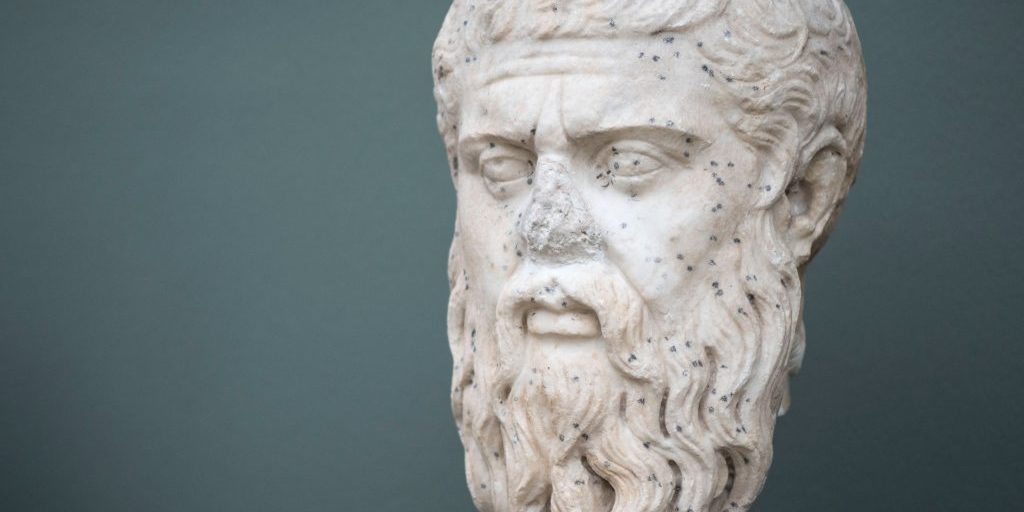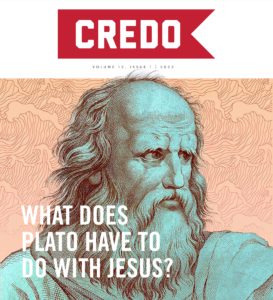
The Contemplation of the Good, Beautiful, and True
The latest issue of C redo Magazine focuses on Christian Platonism. The following is one of the issue’s featured book reviews by Scott Meadows.
redo Magazine focuses on Christian Platonism. The following is one of the issue’s featured book reviews by Scott Meadows.
The target goal for From Plato to Christ is to argue for the applicability of philosophy, notably sourced in Socrates and Plato, toward the Christian faith through the “contemplation of what Plato called the Good and later Christian theologians called the Beatific Vision.” In the same way that Rome prepared the physical roads for evangelizing the gentiles, so does Markos argue that Platonic thought prepared the way for the Christian doctrine to be revealed in Christ.
Plato’s Pre-Christian Vision
Part one, “Plato’s Pre-Christian Vision” provides an introduction to Platonic thought by engaging with the variety of writing, themes, and teachings available to us today. Inspired by the deconstructing questions of his teacher Socrates, Markos explains how Plato sought to pursue what virtues like courage and beauty truly were rather than plain examples of them. Tearing through the thought of the day, Markos introduces his reader to Plato’s dividing line between the World of Becoming and the World of Being. Pairing it with the allegory of the cave, an argument is proposed for the Beatific Vision of external light as the source of Good, True, and Beautiful. These transcendentals are then returned to throughout the book as a foreshadowing of the Triune Creator and Father of Lights “in whom there is no shadow of turning”. In the same way that Rome prepared the physical roads for evangelizing the gentiles, so does Markos argue that Platonic thought prepared the way for the Christian doctrine to be revealed in Christ. Click To Tweet
Discussing the Republic, Markos covers the narrative teaching style of Plato and the origin of human dignity received in a divine figure. Discussing opponents to objective morality similar to the thought of the enlighten, Markos claims that the thought of modern philosophers did not appear in Plato’s time “because Plato and Aristotle so thoroughly bested Nietzsche’s ancient heirs that it took them two millennia to regroup.” Considering justice, the lie of callings, and the philosopher kings, connections are made between the educational virtue of Plato and its applicability to the Christian pedagogy. “Today we seek leaders who can think for themselves;” writes Markos on the need for virtuous censorship, “Plato sought rulers who could think right thoughts.”
Briefly covering the mythical narratives of Plato, Markos takes some time to define and discuss Plato’s understanding of the preexistence of the soul and his view of reincarnation. Though Christian orthodoxy does not believe in reincarnation or a partnership with the divine to choose our lifestyle, drink from the river of forgetfulness, and live out ten-thousand years until acceptance into the Realm of Being, Markos argues for the Christian undercurrents and preparation for Christian perspectives on the immortality of the soul. Considering the judgment of a soul, Plato even argues that “souls are stripped of their bodies and judged in a state of utter nakedness” after their death, displaying a certain sense of the law of nature. With a dive deeper into preexistence, Markos describes how Platonic experience of love, beauty, and truth derive from a déjà vu of life once lived facing “on the face of the immortal, the indestructible, (and) the uncreated” before life in the Realm of Becoming. From the sight of beauty in the lover to the final end of life, Markos argues for similarity to Christian thought in the pursuit of Beatific Vision away from images toward reality, away from the ugliness of ignorance, and decay toward beauty, truth, and the eternal.
Brief coverage is included in chapters 5 and 6 in Plato’s philosophy of governing authorities, their approach to virtue, and the need to appease the Gods. This following of an objective moral law of “obedience, not sacrifice,” that the divine figures desire from their people even comes close to the Old Testament’s revelation of the Ten Commandments. Following with considerations of rightly ordered loves, the separation of angels and beast, and the roles of men and women, Markos briefly concludes the final edges of Plato’s picture of man before transitioning to part two.
Plato’s Christian Legacy
Part two, “Plato’s Christian Legacy” is where Markos begins to track Plato’s inspiration in and through orthodox and heterodox Christian thought. Philosophers, theologians, poets, and politicians are all included in this second portion as Markos attempts to show the reader the strengths and weaknesses of Platonic thought on Christian orthodoxy. Considering the “just” man spoken of in the Republic, Markos argues alongside Lewis how such “is the very same thing of which that Passion is the supreme illustration.” In an attempt to bolster his argument, Markos explains how Lewis displayed the strengths of Platonic thought while knowing “the execution of that (his) desire was rendered ultimately futile by the absence of God’s grace in Christ.” Comparing Plato’s doctrine of preexistence with the Christian doctrine of body and soul, Markos exclaims that “Plato did not have access to the first three chapters of Genesis” and would have believed if he had. Though Plato does not hold to a belief in sin, an argument is also made concerning his failing of justice, or what Lewis entitled the Law of Nature, as an error from the path “to yearn after truth and reality, to desire to commune with the one who created us and thus knows our proper telos.” A correct perspective of Plato helps the Protestant remember that “sanctification is a long, slow process in which salvation gives way to transformation” Click To Tweet
Beginning with the heterodox theologian Origen, Markos ironically explains how he “yearned to honor Plato without compromising basic Christian orthodoxy.” With a discussion of Origen’s doctrine of God’s Wisdom as the highest Beatific Vision and Plato’s assistance in identifying sinful desires. “It was imperative for the soul to be trained in the art of making wise judgments,” writes Markos that they might “respond to the call of the spirit – to ascend the rising path out of the cave.”
A brief fly-over is made concerning the three Gregory’s of the east. With the first, Gregory of Nazianzus, Markos explains Gregory’s use of the cave analogy but rejection of Plato’s incorrect view of sin. “Without treating either matter or our senses as inherently evil,” he writes, “Gregory inspires his readers to transcend the limits of the visible to gaze on the invisible God.” Concerning Gregory of Nyssa, Markos explains how he pursued an “allegorical truth” in Plato’s idea of preexistence while denying his “teachings on the transmigration of the soul.” The Beatific Vision arises once again as Gregory of Nyssa exclaims, “This truly is the vision of God: never to be satisfied in the desire to see Him.” With the Final Gregory Palomas, Markos explains how a correct perspective of Plato helps the Protestant remember that “sanctification is a long, slow process in which salvation gives way to transformation” as said “initiates” slowly conform into the image of Christ and the transcendental Goodness, Truth, and Beauty.
Augustine, Boethius, and Dante
In the next section, Markos introduces us to the West with Augustine, Boethius, and Dante. Concerning Augustine’s conversion, Markos explains how “the Manichaeans led him astray” but “the Neoplatonists helped set his feet on the proper road toward truth.” Following the Beatific Vision, Augustine is argued to have identified how Christian sanctification and participation with the Spirit fulfilled the virtues many Platonists sought after. Boethius’s partnership with Platonic thought, argues Markos, helps us to understand how “God speaks to the world through both general and special revelation.” This argumentation seeks to confirm the existence of truth in pagan philosophical thought without forcing it through a Biblicist hermeneutic. Finally, Markos discusses the Platonic inspiration of Dante and his work in The Divine Comedy. This inspiration can be found in how Dante’s journey is “ultimately a spiritual and internal one.” Likewise, Dante thought high enough of men such as Plato and Virgil to give them “the full extent of their own desires and imaginations” in the Elysian Fields of the first level of hell, to eternally contemplate and philosophize but to not end conclusions. Following the Beatific Vision, Augustine is argued to have identified how Christian sanctification and participation with the Spirit fulfilled the virtues many Platonists sought after. Click To Tweet
Considering Erasmus and his reliance upon classical education, Markos argues how Erasmine thought desired to reconcile pagan poetry and philosophy as “a natural doorway to mature meditation on Scripture.” Descartes’s desire for truth-seeking lead him to move away from the deceitfulness of senses “based on opinion rather than knowledge” and the contemplation of a higher infinite God. This led to his apologetic method of acknowledging God’s infinity in light of his finite nature. Finally, Markos considers Coleridge and his Platonic idealism of the imagination as salvation from “aggressive materialism that reduced everything to objective (natural) processes.” By this, explains Markos, Coleridge balms the seeming separation between Plato and the Poet, formerly separated through the consideration of beauty and art as a shadow of reality.
Markos ends From Plato to Christ with a final exhortation toward Lewis. Discussing his fascination with choice in the Christian life, Markos quotes Lewis on how “our choices not only carry immediate consequences; they also shape our souls.” Where Plato lacked the doctrine of sin and justification, Lewis makes up for enmity with God by inserting Christian doctrine into Platonic thought. Rather than viewing fallen man as one in need of virtuous improvement, Lewis argues that “he is a rebel who must lay down his arms” to the Father through the justice and harmony of sanctification in Christlikeness. Tearing apart Plato’s belief in reincarnation, Lewis introduces the existence of heaven and hell into the narrative. Those who live in hell, argues Lewis, “prefer the darkness of the cave to the painful light of the Sun.” Likewise, Lewis describes heaven not only as the place of final Beatific Vision in the Realm of Being but rather as the truest reality. “Heaven is not a state of mind. Heaven is reality itself. All that is fully real is heavenly.”
Concluding From Plato to Christ, Markos laments that Plato was “denied the special revelation of Christ and the New Testament.” Though he affirms the fact that Plato is not, and cannot be in heaven according to Christian doctrine, he still argues that we should engage in Platonic reading in the same manner as our brothers in the historical faith. “I can attest that reading Plato has made me want to be a better man,” writes Markos “to ascend the rising path and find my true telos, the higher purpose for which I was born.”

